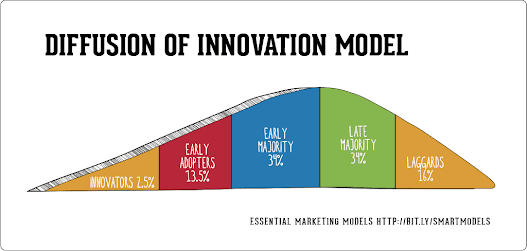The image above shows a visual representation of Everett Rodgers' theory: Diffusion of Innovations. This theory that explains how people take in new ideas through four different elements: the innovation itself, communication channels, time, and social systems.
For this post I will further explain this theory by using Facebook as an example.
Innovators: Facebook wasn't always for our parents and grandparents. Once upon a time, Facebook dominated the social media market. In February of 2004, Mark Zuckerberg launched The Facebook, which originally was meant for fellow Harvard students to connect with one another (think LinedIn but for friends). After over a thousand people registered for the site a day after launching, the site quickly expanded becoming one of the most significant social media companies in the world. Of course, this success came after some failures. Zuckerberg created FaceMash, a site that allowed Harvard students to vote on which two randomly selected Harvard women was prettier, just a year before Facebook. Naturally, there was some backlash from various parties about this site, but Zuckerberg knew he could make something out of his site-making skills.
(Example of a post from FaceMash)
Early Adopters: Facebook was a hit with college students, naturally, that is who it was marketed towards. After FaceMash, Zuckerberg was a big man on the Harvard campus, so naturally he had a pretty big following ready for the launch of his new site. This obviously worked in Facebook's favor as the site received over one thousand registered people on the first day of the launch alone-and it was only available to people with a Harvard email address!
Early Majority: Facebook started as a closed community, available only to Harvard students, but branched out peaking the interest of other college students, making it available to virtually every college campus in the United States and Canada. Facebook started to take the younger MySpace users as they were interested in the newer features of the newer social network. In May of 2005 when Thefacebook officially became Facebook the network was open to high schoolers.
Late Majority: With so many other social networking sites and apps being created like Instagram and Twitter, it seems as though Facebook is for our parents and grandparents. According to Sprout Social, Facebook users aged 65 and older are the quickest growing age-group on Facebook making up 40% of their users. Teen users are quickly declining according to Sprout Social, "In 2015, 71% of teens were active on Facebook. Currently, only 51% of American teenagers between 13 and 17 years old, use Facebook."
Laggards: As various social media networks are becoming more and more popular or more are being invented (Twitter, Instagram, Tik Tok) Facebook seems to be seeing a drop in new users as they are not coming up with the newest in the design for networks.
Overall, after looking at Facebook through the lens of the Diffusion of Innovations model I found that as with everything else, all good things must come to an end, and while Facebook has not yet died, we may see that it will soon disappear as MySpace did with the rise of new inventions.
Sources:
https://en.wikipedia.org/wiki/Diffusion_of_innovations
https://blogs.cornell.edu/info2040/2017/09/15/the-science-behind-social-networking-and-why-myspace-lost-to-facebook/
https://www.history.com/this-day-in-history/facebook-launches-mark-zuckerberg
https://smallbusiness.chron.com/breakdown-facebook-users-age-63280.html







No comments:
Post a Comment